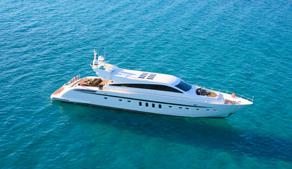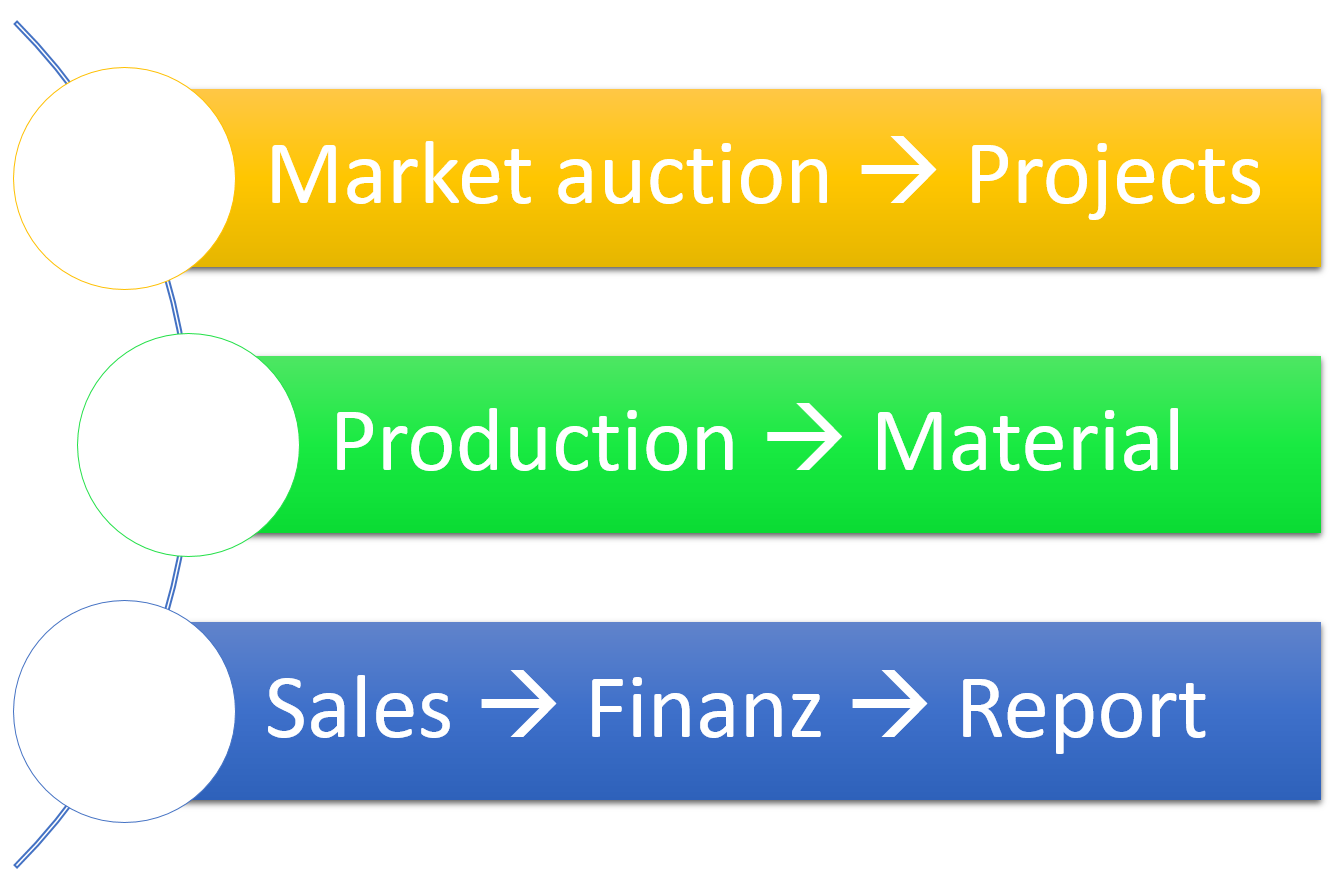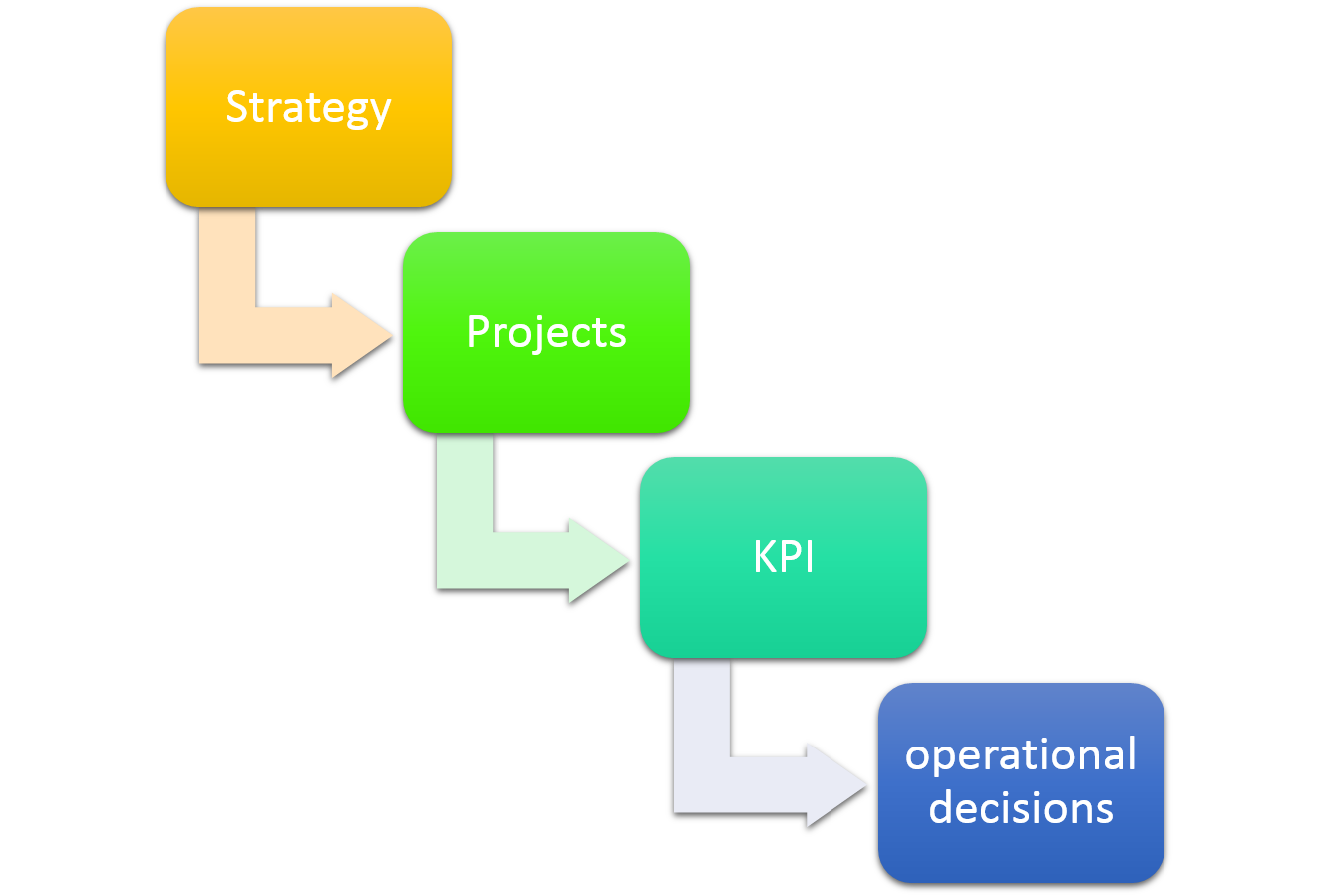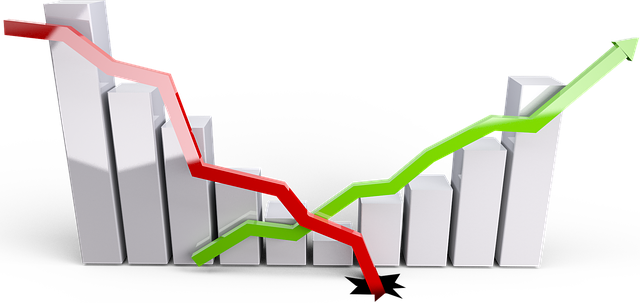- Founding
- Process
- Projects
- Production
- Marketing
- Finance
- Knowledge
- Didactics
What the simulation game is about
You run an public company for 12 quarters, which produces high-quality products. The aim is to achieve the best possible result in accordance with the chosen strategy. Your results are compared with those of the other teams, creating fun and excitement.
Founding - Initial capital
The company generates high quality products and has existed for many years in the form of a private unlimited company. The prices of the products are between 6 million and 18 million. You can give your imagination free rein and imagine a product. It could be lifts, robots or one of the examples below. The former partnership has only produced the product line "Basic". Your task could be to develop more upscale product variants "Classic" or "Premium". Whether this makes sense depends on the strategy chosen.



This company has now been converted into a public limited company. The founder family supplies 60 million as initial capital. The board of directors consists of the heads of the family. You have been employed to manage the business. Brainstorm for a name and a logo this company. The managing board consists of the following positions, which have to be distributed among your team:
- The head of marketingis responsible for the marketing orientation, this job includes taking care of markets and demanded products, working on offers, as well as determining the prices in cooperation with the head of finance. The capacity is evaluated with the head of production. Sales plans are to be developed, key figures to be calculated and these are also to be compared in plan actual.
- Head of Production has to take care of the cost efficient acquisition and production of materials and is responsible for the on time completion and delivery of the orders. Production schedules have to be appointed, the overheads in this area have to be analyzed and key figures evaluated.
- Head of finance has to attend to the development of liquidity as well as monitoring the economical efficiency of the company. Also doing accounting tasks such as working out the balance sheet, profit and loss, investment list and finance plan, calculating key figures in this area, evaluating investment projects, and looking to get the best possible financing.
Choose one of the above listed positions within the company. You are now responsible to the board of directors, especially to deliver the exact business reports. You have now signed a three year contract for this position, a termination is out of question! The management team has decided to switch the positions of the managing board annually according to the job rotation principal. This is to enable an deeper insight and understanding of how all areas are interconnected with each other.
Opening balance in millions
| Assets | Equity and liabilities |
| Factories | 20 | share capital | 60 |
| Maschines | 30 | Surplus | 0 |
| Total fixed assets | 50 | Total Equity | 60 |
| Raw material | 9 | Loans | 80 |
| semi-finished goods | 15 | trade payables | 10 |
| finished goods | 15 | ||
| trade receivables | 40 | ||
| Cash | 21 | ||
| Total current assets | 100 | Total borrowed capital | 90 |
| Total assets | 150 | Total capital | 150 |
The company has so far only produced basic products. You can view the current balance sheet when starting the game.
It is not necessary to have read the entire set of rules before starting the game. Just get started, and if needed consult the help function or watch the videos!
Process and downloads
You can also play alone against 3 avatars. As group game it is far more exciting though, when several teams battle with and against each other. As many teams as you would like can participate in one game, which then will be grouped to form organizational units of four teams altogether. Thanks to the ranking of all teams within a game the sportsmanlike ambition is easily awoken.
The first step is to define one or more individual teams. Then you can start a new game and if required open several organizational units. Each organizational unit can contain four teams and can begin the game independently of other organizational units once all teams have joined. Should you wish to play on one device with several teams simultaneously you have to open an individual browser for each team.
At the beginning you conduct a plan for this period and define the goal, you would like to achieve within your period in this function.
You manage the company for three years and have deliver a full repot each quarter. The game is stunted in 12 quarters. Each quarter you’ll have to make the following decisions:
- Projects are influencing the Key Performance Indices (KPI) which in turn affects the possibilities within the operating business. You are able to start between one and three projects each quarter.
- Production Based on agreements with the head of sales and finance regarding production you determine the capacities (factories and machines), run the quality checks and plan production schedules and organize the accumulation of the necessary material. If the KPI allows it you can also develop new products.
- Marketing and Sales You can open sales offices in three markets and participate in international tenders. If the regarding KPI is in the green area you can win new customers with benefits, which will regularly purchase specific products as well as place additional orders (without causing additional direct costs). Additionally you can buy and sell products at the spot market at any given time. The prices there are considerably lower though.
- Finance and Reports You supply the required financial means and find the ideal forms of financing. At the end of each quarter you write the reports (balance sheet, profit and loss) and calculate the key figures.
 The control panel provides a quick overview of your company. You can open the fields in any order. You can no longer do business if you have paid the fixed costs in the area of finance. This marks the start of the quarterly financial statements. It would be advisable to first generate orders in sales and take part in the tenders (market auction). The other planning is then derived from the order backlog.
Before you start production planning, you should check the KPI. Perhaps you can still produce more. The checklist shows you what you have already done. You do not always have to complete all points (e.g. shares or loans). We recommend that you complete the tasks marked in yellow.
The control panel provides a quick overview of your company. You can open the fields in any order. You can no longer do business if you have paid the fixed costs in the area of finance. This marks the start of the quarterly financial statements. It would be advisable to first generate orders in sales and take part in the tenders (market auction). The other planning is then derived from the order backlog.
Before you start production planning, you should check the KPI. Perhaps you can still produce more. The checklist shows you what you have already done. You do not always have to complete all points (e.g. shares or loans). We recommend that you complete the tasks marked in yellow.
Together you analyze them evaluation and compare it with the intriguing results of your competitors. From this valuable information you derive your decisions for the following quarters.
Downloads:
Quick start Guide:  |
Sales plan: |
Report: |

The following KPIs have a direct impact on operational decisions:
| Customer satisfaction | If your customers are satisfied, you can generate after-sales sales without direct costs and the debts are settled on time. |
| Customer acquisition | If you start projects to acquire new customers such as trade fairs, you can raise this KPI to the green area and thereby acquire new relationship customers with regular orders every quarter. |
| Product development | If you create an innovative working atmosphere in your company, you can develop new product lines. |
| quality | Start projects in good time to ensure the quality of your production and avoid costs for post-processing. |
| Stability | If your production is stable, e.g. there are no interruptions due to machine failure, you can take an additional shift without any production costs. |
| Employee productivity | By means of suitable projects, you can increase the efficiency of production and also occupy an additional shift without production costs. |
All other KPIs have an indirect effect on the ones listed above.
Don't let the variety of projects confuse you! Try it out. If you have played BIZilliance more often, you will recognize the interactions.
 |
Production und Innovation |
- When KPI quality is green, all products pass the quality inspection.
- If KPI quality is yellow, a product must be reworked with rework costs of +1 million.
- If KPI quality is red, all products must be rebuilt with costs per piece of +1 million.
Investment of fixed assets
The delivery time for a new factory is 2 quarters. The purchase price of 20 Millions is only due upon delivery and will be debited directly to the credit account.
You can also rent a factory for 1 million per quarter. In the finance section, you can sell and rent a factory again. This will allow you to increase your liquidity.
From year 2 onward you can sell a factory for 120% of the book value.
Machines are immediately available after purchase for 10 million and can not be rented. When you sell a machine, you receive 80% of the book value.
The useful life of all assets is 10 years. Depreciation takes place automatically when paying the fixed costs.
Production planning and occupancy of the machines
Each machine is assigned a product type (Basic, Classic or Premium).
By clicking on the product type, you can convert the machine as far as the desired product type has already been developed. The costs for the conversion amount to 1 million.
Each machine has a day and a night shift. You can click on each shift, but you can not reverse your choice.  The material sets are taken from the material store. Therefore, you should already carry out the production planning for the following quarter in the current quarter and order the required material sets. Wages for the night shift are 20% above those of the day shift.
The material sets are taken from the material store. Therefore, you should already carry out the production planning for the following quarter in the current quarter and order the required material sets. Wages for the night shift are 20% above those of the day shift.
For the production per piece you pay direct costs (for wages, energy, etc.) of 2
Million/machine and shift for the product type BASIC and 3 million/machine and shift for the product type CLASSIC. For the product type PREMIUM the
production period amounts to 2 quarters with production costs of 2 Million/machine. The production costs are therefore dependent on the product!
The production costs increases for the
night shifts due to overtime by 20%.
The production costs are to be paid in cash.
Attention: Decisions regarding the conversions to different product types or occupancy in terms of shifts of machines can not be reversed.
Additional production
If the stability and employee productivity are high, the output may be increased without an additional raise in production costsn as the machines are better utilized.
If KPI stability is green, then another piece can be produced per factory. If KPI stability is red, the output is reduced by one piece per factory.
If KPI employee productivity is green, then another piece can be produced per factory.
If KPI employee productivity is red, the output is reduced by one piece per factory.
Example: if both KPIs are green, you may additionally produce 2 pieces per factory !
Attention: In order to make use of the additional production, all the machines with the corresponding shift (day or night shift) per factory must already be in use.
Innovation and product development
The product type BASIC is in the mature state, i.e. high numbers of it are in demand, however the average price is expected to fall. Further product generations are foreseeable.
If KPI product development is green, then the innovation process can be continued to develop a new product. The wages for the development team are 3 million per quarter.
If KPI product development is red, the completion date for the
product development will be shifted back by 1 quarter. This means that, due to the poor innovative climate in the company some of the developments already made are lost again.
For every new product, a development team has to be employed. A development team costs 3 million per quarter. Several development teams at a time can also be hired. If the KPI is green one development step can be done per quarter. Products can only be produced once the completion of the development has occurred fully. Offers can, however, be placed independently of the development status!
You can have an overview of the duration of the product development if you click on the product development.
 |
Sales & Marketing |
are regular customers in the central market, which consume certain products to selected prices regularly.
If the KPI customer acquisition is green, then you can select a customer with benefits per quarter. Pay attention to the duration and frequency. 1 means that the customer orders every quarter and 2 means he orders every 2nd quarter. The orders of customers with benefits will appear automatically in the list of open orders.
If the KPI customer acquisition is red, then a customer with benefits is lost. You then have to click on an already selected customer with benefits and his orders will be deleted in the list of open orders.
Market auction
Here are the international tenders. You can open one sales office in each, the East and West market. Click on the appropriate market. The opening or closing of a sales office causes sales costs of 4 or 2 million. The running costs of a sales office amount to 2 million per quarter.
You can participate in 2 tenders per market and quarter at a time. In the list of tenders you can see the expectations of the customers, which you can change in terms of the order value, the payment date and the delivery time in the offer, but you can not exceed a value over 50%.
The date bar at the top shows how much time you have left for the placement of your offer. The
rhythm (the duration between the due dates of offers) is defined at the game opening.
If you have placed all your offers, please confirm with "no offer left“. Then check the status to see if the other teams have submitted their offers.As soon as all teams have completed the offer phase or the deadline has been reached, you will receive an assessment of the distribution.
The customers rank according to the cash value, the payment term and the delivery date. If one of your offers has been accepted, it will be marked with the green circle and automatically be transferred to your open orders.
Market leadership
If you are the market leader in one of the 3 markets, you can place 3 offers instead of 2 in the following period and the first offer will definitely win the bid. You will have to meet the expectations of the customers however.
Open orders
In the upper part you see the warehouse of finished goods. The lower part shows the orders to be delivered. Pay attention to the delivery date. If you fail to comply the delivery date, a penalty of 10% of the order value per quarter will be charged. Per 10 delivered material units incur logistics costs of 3 million.
Spot market
You can buy basic products on the spot market. The products are immediately available for a purchase price of 8.
The spot market is unlimitedly receptive to basic products at a selling price of 6. The payment term is 2 quarters.
After-Sales Turnover
With an after-sales turnover there are no additional direct costs. For example, if a customer is satisfied, they will sign a service contract that can be met by your staff at no extra cost.
If KPI customer satisfaction is green, an after-sales turnover of a new customer can be generated for after-sales.
 |
Finance Section |
You should receive the payments from your customers at the beginning of each quarter.
If however the key performance indicator customer satisfaction is red, then 50% of the customers in the first accounts receivables column will only pay one quarter later.
You can see the time for payment of the accounts receivables diagrammed in quarters and you have the option to resign them to a factoring bank. If you wish to do so please insert the desired amount. You will immediately be credited for this amount in cash (liquid funds). You pay the factoring expenses of 2% per quarter at the end of each quarter.
Liabilities
Here you can see the time for payment of accounts payables diagrammed in quarters. You will have to pay the payable amount for the current quarter directly and without a cash discount. Also you can choose to pay right now for accounts payables of later quarters with a cash discount of 5% by entering the desired amount. Keep in mind that the cost-efficiency is considerably higher, - should you not have enough cash at your disposal you can take out a loan to get the cash discount.
In the lower part you can raise or lower the credit level within your credit limit. If your credit limit is exhausted, you can claim an overdraft facility at twice the current interest rate of 5% per annum. However, you should pay it back in the following quarter. If this does not succeed, the double interest rate applies to the normal loan as well.
Fixed costs
The billing of fixed costs represents the last activity of a quarter. Afterwards you can no longer transact business!
Fixed costs |
Value in millions per quarter |
Description |
Selling expenses |
2 |
Costs per sales office |
Selling expenses |
4 +2 +1 |
Administration costs, purchases, etc. Per 10 purchased material units |
Logistic expenditure |
3 |
Costs for logistics and stockkeeping |
Interest |
1.25% |
5% p.a. |
Factoring |
2% |
per quarter: sale of receivables |
Rent |
1 |
per factory |
- |
machinery can not be rented |
|
Development costs |
3 |
Pro Per |
Conversion costs |
1 |
Per machine |
Consultancy fees |
1 |
If you did not create the report yourself |
The taxes of 25% of the result of ordinary activities are calculated and imposed once at the end of the year. The billing of taxes is, however, only 2 quarters later.

Shares
The capital stock of each team is divided into a certain number (eg 100,000) shares. The number is stored in the game file. The subscription price is above 20% of the nominal value, ie at 60 million share capital, the price is 720, -. Each team can buy and sell shares of another team in the same game. The game applies the same set of rules as a real stock exchange.
All orders are saved on the server and remain in effect until either the purchase or sale is concluded or the order is deleted.
Fixing and billing
You can buy or sell your shares and place your orders at any point within a quarter. However, you can only use the "Status" to trigger the pricing and execution once every quarter. Wait for the other teams to place their orders as well, otherwise due to lack of supply or demand no deals can be executed.
Once you have clicked the button "Status" in the main program each quarter, you will see which deals were made and the corresponding revaluation to your account. The current amount in your account illustrates how many shares you have already successfully been able to note as „sold" in your order book.
Within the game frame a specific rhythm is defined, by which each price fulfillment is determined. This rhythm is asynchronous (that is, it does not wait for all teams) and will therefore deviate from the placement of offers (it will be shorter paced). Once the deadline has been reached, the data in the order book is processed and the price fulfillment at which the highest turnover can be achieved is determined. There are also partial sales / purchases possible.
Types of orders
When making a purchase, you can choose the following additional functions:
- cheapest: The purchase is likely to run at the cheapest price. Since the market in this game is very narrow, usually only a few teams buy and sell, it can also come to a surprisingly high course. Therefore, be careful here.
- Limit: Here you specify the upper limit up to which price you want to buy the stock. If there are few offers on the market, it may be that there is indeed no execution.
- Stop buy: This defines the lower limit from which on you want to start buying the shares. This particular function makes a lot of sense for example when you want to buy a share that is in an uptrend. Here it can also lead to unintentionally high purchase prices due to the small size of the market.
When selling, you can choose the following order types:
- Best: The purchase is likely to be executed at the best price. Since the market in this game is very tight, usually only a few teams buy and sell, it can also come at a surprisingly low price. Therefore, please be careful.
- Limit: Here you determine the upper limit, from which on you want to sell the shares. If there are too few buyers in the market, it may occur that there is indeed no execution.
- Stop loss: This defines the lower limit from which on you want to sell the shares in any case. This especially makes sense for you, if you fear that the price (value) will fall sharply. Here too this can result in unintentionally low price fulfillment due to the small size of the market.

Questions open the mind!
Goethe
Brain research confirms that increased brain activity is detected after a question. A question arouses more interest than a normal text.
Teams can answer random questions at any time. You have 3 wild cards throughout the game that you can use strategically. This gives the microlearning a playful component and increases the motivation to deal with the topic.
If the teams answer at least 3 questions per round (= quarter), the percentage of correctly answered questions will be included in the benchmarking and ranking. This makes microlearning even more exciting. For example, it could be shown that a team with the best theoretical knowledge might perform worse than other teams in applying this knowledge in the simulation.
Questions of your company
To add value to microlearning, you can enter specific questions from your company. Thus, the ranking of knowledge gains additional importance. You can connect the questions with pictures, sounds or videos. For the learning effect, it would be important to provide an accurate explanation of the right solution.
You are very welcome to use our didactically experienced employees in formulating and entering the questions in the system.
If you do not provide specific questions from your company, the questions will be drawn from a pool of about 300 business questions.
After you have completed the quarter, all data will be transferred to the BIZ server. This allows you to exit the program after creating the report and continue it at a later time.
When all data has been transferred (all areas are marked in green) you can continue. If this is not the case, you can repeat the process. If it doesn't work the second time either, please check your internet and start the game again.
How well do you know your own company?
After the server comparison, you will receive a randomly selected question about a key figure that you estimate without any documents. The absolute differences then appear in the ranking and benchmarking.
Report
You are now called upon to present the report for the past quarter. In each of the 3 areas (balance sheet, profit and loss statement and quick test) you have 5 options to create a correct report. You will receive good help and tips. If that doesn't work, or if you don't even want to try it yourself, you can outsource the work to a consultant whose fee is 4% of sales.
In any case, you must submit the report (regardless of whether it is yourself or outsourcing) so that a comparison with the other teams (benchmarking) is possible.
After submitting the report, you will receive some interesting evaluations that you should analyze carefully. However, the target / actual comparison only becomes more meaningful in the later quarters.
Development
Here you can see the development of your company up to the last quarter. You can call up the current development in the evaluations of the report.
Benchmarking and Ranking
Here you can compare your results in 14 different categories with the other teams in your organizational unit. The prerequisite for this is that all teams have created their report. If a team is missing, you should wait or get in contact with this team.
If several teams play in one game, you can call up the exciting ranking, which extends across all organizational units. You learn most by comparing it with other teams. You can sort the results in the ranking differently and call up all detailed evaluations by clicking on the team's logo.
Target / actual comparison
The last evaluation shows you how well you have planned. Your annual planning will be extrapolated to the quarters and the results towards the end of the year will be more precise. The absolute differences appear as a planning index in the ranking and benchmarking. The lower this is, the better you have achieved your plan.
Then you decide whether you want to continue the game later or start the next quarter straight away.
 |
Didactics |
Preparation
If the participants have read the description and played the demo version, one quarter is sufficient, otherwise at least 2 quarters should be played together, explaining the operation via the projector and encouraging them to read the help information. Then a game should be played by the teams (with 3 members) on a trial basis without rating in order to gain the necessary security and to clarify all questions.
Execution
After the test game, a challenge can be played. It would be good to change roles within a team every year and possibly to represent this with cards. The CFO should write down the values in an Excel model on his own PC in order to be able to process the quarterly financial statements quickly.
Duration
The game lasts for 12 quarters. The duration depends, among other things, on whether the financial statements are drawn up yourself or transferred to a tax advisor. The integrated stock market game also takes more time. If you don't do the closing yourself, the entire game will take around 8 to 10 hours. Do not save on the evaluation and analysis of the results, as this has the greatest learning effect. You can quit the game after each quarter close and continue later.
Presence or distributed
The game can also be distributed (e.g. at home). If the team members are not playing in one place either, they can work via a telephone conference such as Skype or Teamviewer or via video conference such as WEBEX, Teams or Zoom (it is ideal to assign each team to a breakout room). If possible, only one team member should enter the decisions, it is also possible that all members operate the game during a quarter. However, only those entries of the member who is the last to carry out the syncronisation with the server apply. The game management can follow the progress of the game online, comment on it and intervene if necessary.
Debriefing
At the latest at the end of each year, the results should be compared, analyzed, discussed and then roles swapped. The knowledge and decisions gained from this should be recorded in writing. The comparison with other teams is particularly instructive. It is important to analyze the information (e.g. balance sheets, P&L, key figures) and interpret it correctly. Try it on the basis of this elaborated example .
Competence-oriented performance assessment
As in business practice, the central competence of leading the company successfully (e.g. increasing equity) implies a variety of other competencies. For example, it is not sufficient to be able to define and calculate key figures, rather it is crucial to be able to interpret them and derive the right decisions from them.
The advantage of building the performance assessment based on the results of the simulations is also that they are completely objective and transparent.
The game management can call up an analysis of the results and the competence-oriented performance assessment for all teams that have completed the game . A grade is also suggested. The assessed competencies can be individually weighted by the game management, whereby a new grade is automatically calculated.
Just give it a try by following the Example of the FH Wels click on the logo of a team and then select Analysis.
Competencies for the future
The advancing development of digitization and especially of artificial intelligence will fundamentally change the professional fields of business school graduates.
For example, booking records will be generated automatically by the system and this will make this competence much less important.
On the other hand, the following qualifications will become more important in the future:
- Develop strategies,
- implement these in medium-term planning,
- filter the necessary information for decisions from big data,
- interpret them correctly and implement them in decisions.
- Communicate in a team and develop creativity
- and understand the relationships between different areas of a company
- and be able to recognize the effects of their decisions.
